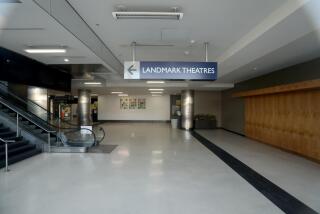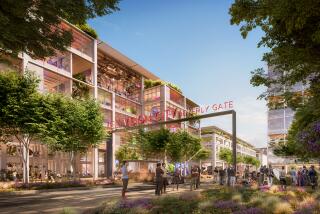Neighbors Marshal Objections to Shopping Center Proposal
- Share via
Some Westside residents are preparing for what could be a heated confrontation with builders of the Westside Pavilion at a hearing before a Planning Commission officer on Monday.
The builder, Westfield Inc., has asked for a zone change from residential to commercial for part of a lot on the southwest corner of Pico and Westwood boulevards, where Westfield wants to build another shopping center.
The Pavilion, which opened last year, is on the southeast corner of Westwood and Pico. The builders want to link the two centers with a 120-foot-wide bridge that would span Westwood Boulevard at a height of 37 feet.
The Monday hearing will be held at 9:30 a.m. in the West Los Angeles community building at 1645 Corinth Ave.
Representatives of a number of homeowner groups said that an area of particular concern is a finding by the city Planning Department that the project will not have a significant impact on the environment, provided certain things are done by the builder. These “mitigating measures” include the widening and restriping of Westwood Boulevard, an agreement to rent space only to businesses that would not attract large numbers of customers and creation of a buffer zone between the parking area and the residential area behind it.
Disagreement with the city’s findings is detailed in letters written by Westwood Gardens Civic Assn., the Friends of Westwood and the Residents of Cushdon Avenue, among others. Laura Lake of Friends of Westwood said that several other residents’ groups have joined them in requesting a full environmental impact report.
In a letter dated Nov. 12, Westwood Gardens residents compare the proposed bridge to a three-story wall that will cause problems with noise, wind and shadows. The letter accuses the developer of “gross miscalculations” of the parking spaces required for the Pavilion and describes proposed parking for the new building as a “meager increase.”
In the letter residents object to the zone change and the proposed widening of Westwood Boulevard in front of single-family homes. The letter, signed by association President Paul Hurst, calls the building plan a “proposed intrusion into the neighborhood” and describes it as “a bold and extensive attack on (the neighborhood’s) residential structure.”
In its appeal to the city, Friends of Westwood charges that the project would violate Proposition U because it requests upzoning. Proposition U, which went into effect after the Pavilion was built, reduces the permitted size of buildings in some areas.
Residents of Cushdon Avenue, two streets south of the Pavilion, are concerned about a proposal for a cul-de-sac on Ayres Avenue, one block west of the Pavilion. Spokeswoman Susan Carroll said her neighbors fear that shoppers who are now traveling on Ayres will begin to use Cushdon.
Marilyn Tusher, a member of the task force created to negotiate with the builders, charged that the proposed bridge would not ease the traffic flow, but would only benefit the developer by encouraging customers to move from one shopping center to the other.
The people who live closest to the Pavilion said that the lights, noise and automobile fumes destroy the quality of the community, and they fear that the new building will only add to these problems.
Councilman Zev Yaroslavsky said that the major issues are development of the residential zone, parking, traffic circulation and the size of the bridge. He said that more parking and modifications of the bridge are necessary.
Yaroslavsky said the zone change would be issued only with conditions attached, among them a requirement that no building ever be placed on the rezoned portion of the lot that for 40 years has been used for parking under a zoning variance.
The extent of widening and restriping of Westwood Boulevard, plus an examination of the number of trees that would be affected, is still under study, as is the possibility of placing a cul-de-sac at Ayres Avenue, he said.
“I’m convinced that most of the issues are resolvable,” he said.
“We try to analyze what will be best for the community as a whole and what is best block by block,” he said. “The hearing is designed to ferret out issues. . . . Hopefully some kind of synthesis of all these things will occur.”
More to Read
Sign up for Essential California
The most important California stories and recommendations in your inbox every morning.
You may occasionally receive promotional content from the Los Angeles Times.










